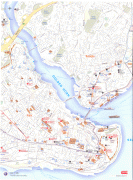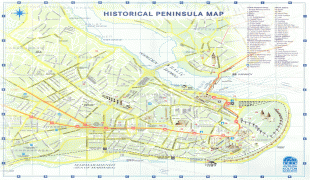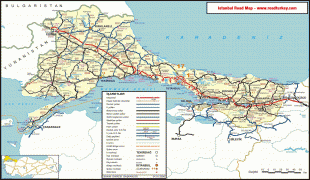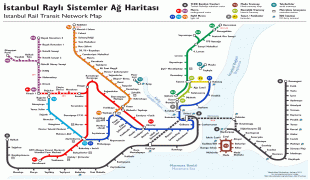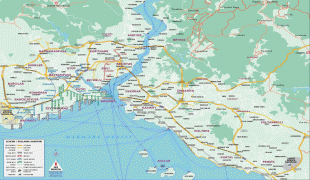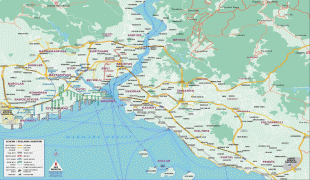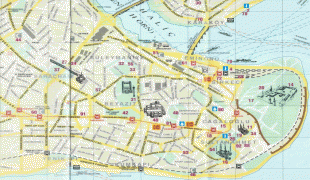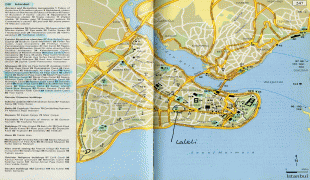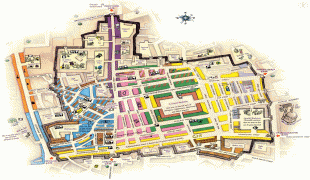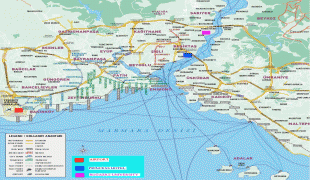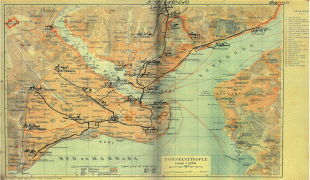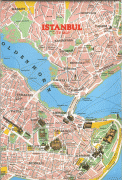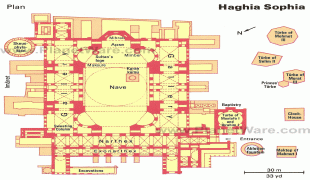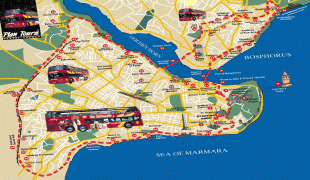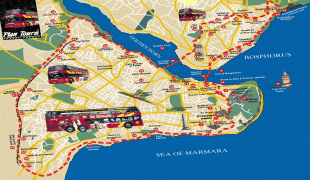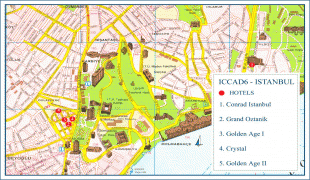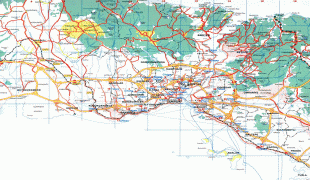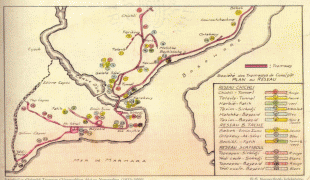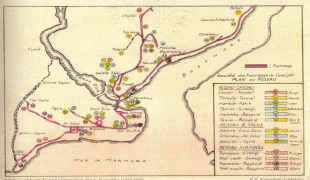Constantinople (Istanbul)
Constantinople (see other names) was the capital of the Roman Empire, and, later, the Eastern Roman Empire (also known as the Byzantine Empire; 330–1204 and 1261–1453), the Latin Empire (1204–1261), and the Ottoman Empire (1453–1922). Following the Turkish War of Independence, the Turkish capital then moved to Ankara. Officially renamed Istanbul in 1453, the city is today the largest city and financial centre of the Republic of Turkey (1923–present). It is also the largest city in Europe.
In 324, the ancient city of Byzantium was renamed "New Rome" and declared the new capital of the Roman Empire by Emperor Constantine the Great. On 11 May 330, it was renamed to Constantinople, and dedicated to Constantine. Constantinople is generally considered to be the center and the "cradle of Orthodox Christian civilization". From the mid-5th century to the early 13th century, Constantinople was the largest and wealthiest city in Europe. The city became famous for its architectural masterpieces, such as Hagia Sophia, the cathedral of the Eastern Orthodox Church, which served as the seat of the Ecumenical Patriarchate, the sacred Imperial Palace where the Emperors lived, the Hippodrome, the Golden Gate of the Land Walls, and opulent aristocratic palaces. The University of Constantinople was founded in the fifth century and contained artistic and literary treasures before it was sacked in 1204 and 1453, including its vast Imperial Library which contained the remnants of the Library of Alexandria and had 100,000 volumes. The city was the home of the Ecumenical Patriarch of Constantinople and guardian of Christendom's holiest relics such as the Crown of thorns and the True Cross.
Constantinople was famous for its massive and complex fortifications, which ranked among the most sophisticated defensive architecture of antiquity. The Theodosian Walls consisted of a double wall lying about 2 km to the west of the first wall and a moat with palisades in front. Constantinople's location between the Golden Horn and the Sea of Marmara reduced the land area that needed defensive walls. The city was built intentionally to rival Rome, and it was claimed that several elevations within its walls matched Rome's 'seven hills'. The impenetrable defenses enclosed magnificent palaces, domes, and towers, the result of prosperity Constantinople achieved as the gateway between two continents (Europe and Asia) and two seas (the Mediterranean and the Black Sea). Although besieged on numerous occasions by various armies, the defenses of Constantinople proved impenetrable for nearly nine hundred years.
In 1204, however, the armies of the Fourth Crusade took and devastated the city and, for several decades, its inhabitants resided under Latin occupation in a dwindling and depopulated city. In 1261 the Byzantine Emperor Michael VIII Palaiologos liberated the city, and after the restoration under the Palaiologos dynasty, it enjoyed a partial recovery. With the advent of the Ottoman Empire in 1299, the Byzantine Empire began to lose territories and the city began to lose population. By the early 15th century, the Byzantine Empire was reduced to just Constantinople and its environs, along with Morea in Greece, making it an enclave inside the Ottoman Empire. The city was finally besieged and conquered by the Ottoman Empire in 1453, remaining under its control until the early 20th century, after which it was renamed Istanbul under the Empire's successor state, Turkey.
In 324, the ancient city of Byzantium was renamed "New Rome" and declared the new capital of the Roman Empire by Emperor Constantine the Great. On 11 May 330, it was renamed to Constantinople, and dedicated to Constantine. Constantinople is generally considered to be the center and the "cradle of Orthodox Christian civilization". From the mid-5th century to the early 13th century, Constantinople was the largest and wealthiest city in Europe. The city became famous for its architectural masterpieces, such as Hagia Sophia, the cathedral of the Eastern Orthodox Church, which served as the seat of the Ecumenical Patriarchate, the sacred Imperial Palace where the Emperors lived, the Hippodrome, the Golden Gate of the Land Walls, and opulent aristocratic palaces. The University of Constantinople was founded in the fifth century and contained artistic and literary treasures before it was sacked in 1204 and 1453, including its vast Imperial Library which contained the remnants of the Library of Alexandria and had 100,000 volumes. The city was the home of the Ecumenical Patriarch of Constantinople and guardian of Christendom's holiest relics such as the Crown of thorns and the True Cross.
Constantinople was famous for its massive and complex fortifications, which ranked among the most sophisticated defensive architecture of antiquity. The Theodosian Walls consisted of a double wall lying about 2 km to the west of the first wall and a moat with palisades in front. Constantinople's location between the Golden Horn and the Sea of Marmara reduced the land area that needed defensive walls. The city was built intentionally to rival Rome, and it was claimed that several elevations within its walls matched Rome's 'seven hills'. The impenetrable defenses enclosed magnificent palaces, domes, and towers, the result of prosperity Constantinople achieved as the gateway between two continents (Europe and Asia) and two seas (the Mediterranean and the Black Sea). Although besieged on numerous occasions by various armies, the defenses of Constantinople proved impenetrable for nearly nine hundred years.
In 1204, however, the armies of the Fourth Crusade took and devastated the city and, for several decades, its inhabitants resided under Latin occupation in a dwindling and depopulated city. In 1261 the Byzantine Emperor Michael VIII Palaiologos liberated the city, and after the restoration under the Palaiologos dynasty, it enjoyed a partial recovery. With the advent of the Ottoman Empire in 1299, the Byzantine Empire began to lose territories and the city began to lose population. By the early 15th century, the Byzantine Empire was reduced to just Constantinople and its environs, along with Morea in Greece, making it an enclave inside the Ottoman Empire. The city was finally besieged and conquered by the Ottoman Empire in 1453, remaining under its control until the early 20th century, after which it was renamed Istanbul under the Empire's successor state, Turkey.
Map - Constantinople (Istanbul)
Map
Country - Turkey
 |
|
| Flag of Turkey | |
One of the world's earliest permanently settled regions, present-day Turkey was home to important Neolithic sites like Göbekli Tepe, and was inhabited by ancient civilisations including the Hattians, Hittites, Anatolian peoples, Mycenaean Greeks, Persians and others. Following the conquests of Alexander the Great which started the Hellenistic period, most of the ancient regions in modern Turkey were culturally Hellenised, which continued during the Byzantine era. The Seljuk Turks began migrating in the 11th century, and the Sultanate of Rum ruled Anatolia until the Mongol invasion in 1243, when it disintegrated into small Turkish principalities. Beginning in the late 13th century, the Ottomans united the principalities and conquered the Balkans, and the Turkification of Anatolia increased during the Ottoman period. After Mehmed II conquered Constantinople (Istanbul) in 1453, Ottoman expansion continued under Selim I. During the reign of Suleiman the Magnificent, the Ottoman Empire became a global power. From the late 18th century onwards, the empire's power declined with a gradual loss of territories. Mahmud II started a period of modernisation in the early 19th century. The Young Turk Revolution of 1908 restricted the authority of the Sultan and restored the Ottoman Parliament after a 30-year suspension, ushering the empire into a multi-party period. The 1913 coup d'état put the country under the control of the Three Pashas, who facilitated the Empire's entry into World War I as part of the Central Powers in 1914. During the war, the Ottoman government committed genocides against its Armenian, Greek and Assyrian subjects. After its defeat in the war, the Ottoman Empire was partitioned.
Currency / Language
| ISO | Currency | Symbol | Significant figures |
|---|---|---|---|
| TRY | Turkish lira | ₺ | 2 |
| ISO | Language |
|---|---|
| AV | Avar language |
| AZ | Azerbaijani language |
| KU | Kurdish language |
| TR | Turkish language |






